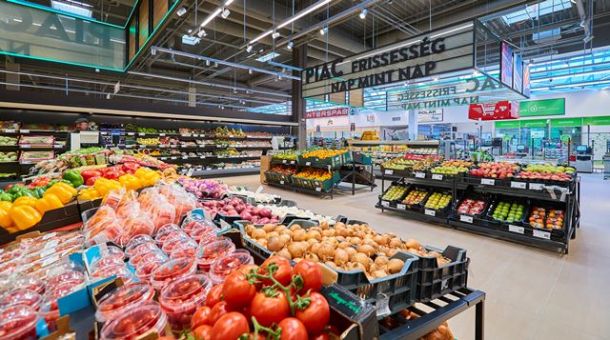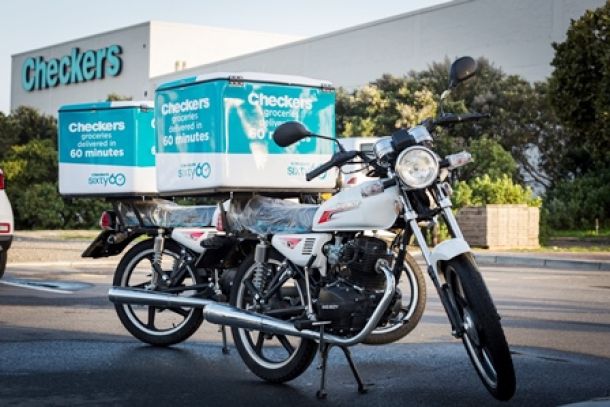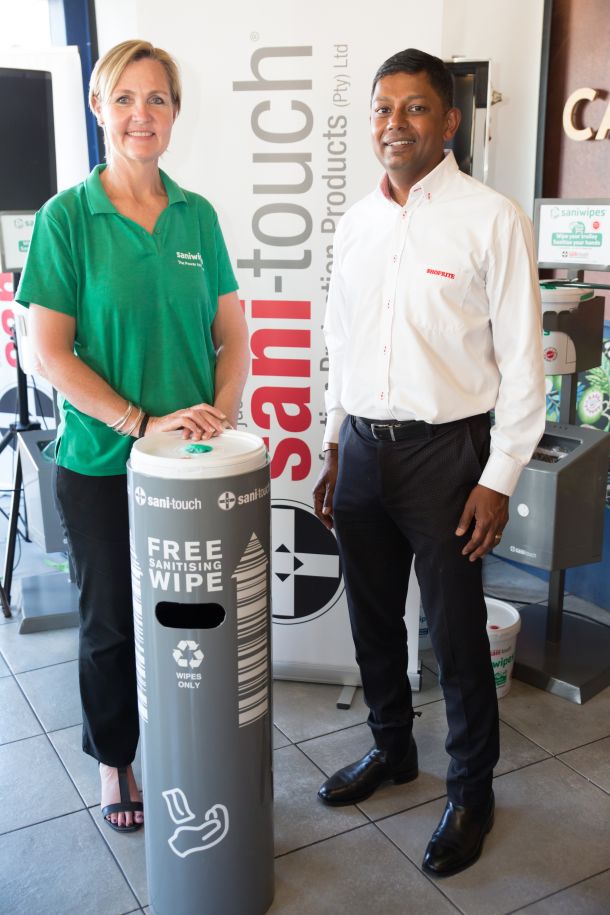UK food retailers get the space race blues
Dear British grocers, Are you having sleepless nights in this e-commerce and convenience store age?
It has reached even our Teutonic ears that you are worried about the vast floor space you have accumulated at considerable expense over the years. For how else are your friends in Germany to interpret your attempts to reutilise store surfaces in your greenfield hypermarkets?
To give just a few recent examples: Tesco has introduced beauty salons and gastronomic concepts such as Harris+Hoole or Giraffe; Sainsbury's is flirting with sport clubs; and Asda has opened local community areas on its premises. Can it be that these interesting ideas, however, aren't quite working as well as you had hoped? Why else, for instance, is Tesco Extra planning to convert more than a third of its floor space in Dudley into a dark store?
We just wanted our English friends to know that we do understand your problems. After all, consumer shopping habits have changed since the financial crisis and those nasty German discounters are making great headway. Meanwhile, even such innocent and honest investment bankers as Goldman Sachs, who had nothing to do with the crisis and who have never trashed your shares, think you will have to close at least 20 per cent of your store space if you want to return to profitable growth.
But, quite frankly, what we don't understand is why our local retailers are so unfazed. After all, we are far more overstored than you on your little island, and many trade gurus believe that we have a third too many stores in Germoney. Puzzled by the un-Germanic nonchalance of our own retailers, we look with fascination at the creative ways you are trying to solve your own problem.
Not wishing to burden your deeply communicative and ever helpful press departments unnecessarily, we thought we would ask two British experts for their take on what is happening in Blighty: Brian Moore, managing director at EMR-NamNews, and Nick Gladding, senior business analyst at IGD, were so kind as to oblige our Germanic curiosity:
"Victims of their own success"
Mr Moore, Goldman Sachs has dubbed "capacity exit" the "only viable solution" for Big Box retailers as they reel from the rise of the discounters and the exodus to online. How did some of the world's best retailers get themselves into such a pickle?
One could say that they have become victims of their own success. In general, UK multiple grocers generate sales of £1,000 per square foot (€14,360 m²) per annum. This level of selling intensity has driven the growth of large space retail, the high quality of build, and the price of appropriate real estate.
It also caused them to apply very low levels of store depreciation, i.e., typical depreciation values of 2 per cent per annum means they are locked into a 50 year assumption that the market will remain the same...Larger space, run very efficiently, meant that the larger multiples were increasingly profitable, generating net profits to the north of 5 per cent per annum, thus fuelling stock market expectations.
How did they try to maintain this high space?
The retailers increased their assortments to create a one-stop-shop environment, often stocking products based on size of trade funding rather than consumer demand. Increased use of private label provided a means of differentiating large stores from competition, and also provided an added bonus of additional retail gross margin. The brand/private label split eventually reached 50/50 in most cases.
So when did things start to go wrong?
I believe that the 2008 global financial crisis was a wake-up call that caused consumers to reassess their weekly/monthly shopping behaviour, moving to smaller, closer, more frequent and more convenient shopping, seeking demonstrable value-for-money in the process. The discounters became more appealing, and the limited choice made for easier, less confused shopping decisions.
The consumer became less willing to journey out of town, meaning that retailers had to acknowledge the redundancy of large space retail. The Goldman Sachs 20-per-cent warning, echoed by Sainsbury's in 2014, caused the major multiples to realise that their larger stores were over-ranged, resulting in systematic checking of traditional assumptions of supply and demand.
How did they try to rectify the situation?
Tesco, for instance, had a product 're-set' or cull, aimed at reducing their 90,000 SKU ranges by 30,000 in a two-year programme. In the process, the company discovered that 80 per cent of sales were made by 20 per cent of the products, with Tesco CEO Dave Lewis stating at an IGD trade briefing in 2015 that 20 per cent of the SKUs in a Tesco Extra store only sell one pack per store per week.
Where are the solutions to the excess space issue, given that retailers are often on long lease contracts or have invested billions in developing the real estate?
Closing stores and/or selling off excess space is theoretically an option, but in practice the problem is that if all four multiples were to put their excess property on the market simultaneously, retail real estate prices would fall through the roof. The 50-year property 'lock-in' means that simply closing a store results in an asset write-down on the balance sheet, and ultimately impacts net margins, already diluted by price wars.
Also, as £1k per annum per square foot is a driver of property value and a basis for setting rental levels in leading-edge retail, any other retailer buying the property would find it difficult to achieve outlet viability in terms of profit. That leaves finding alternative usage in terms of shop-in-shop, or any logical use of the space, with the added appeal of potential extra foot traffic – see Sainsbury's trial and attempted takeover of Argos in recent months – as the only options.
What are the merits and demerits of the various alternatives used by the Big Four in their big-box stores?
All of the 'alternative-use' options have to meet the £1k per ft² per annum criterion in order to avoid dilution of the overall store performance. The excess space usage has to be a logical extension of the store offering and of sufficient appeal so that consumers see some benefit in making an out-of-town trip, compared with accessing the product or service locally.
Having established these criteria, the retailer is free to choose any option be it a third party or a self-owned initiative, providing it is better than any locally available alternatives.
Incidentally, one way for a major multiple to ensure that an alternative business is both viable and complementary to the store offering is to charge a combination of rent and percentage of sales. This was a method pioneered by Kwik Save in their 'delegating' of Fruit & Veg retailing to third parties many years ago in the UK.
How else could retailers make their big outlets into destination locations?
Bricks & mortar one-stop shopping was a great idea in the years of 'full & plenty'. However, in these unprecedented, more austere times the savvy consumer has emerged, demanding demonstrable value-for-money. Now the consumer needs to shop smaller, faster, closer and more conveniently.
This means that, even if they can be persuaded to make out-of-town trips to spend £10, then the cost of petrol becomes a consideration that did not impact their purse when a shopping trip resulted in a £70+ basket. The real issue is that these changes in behaviour are fundamental, structural and 'permanent' in the sense that it is difficult to anticipate any appreciable increase in flat-line demand, let alone any return to the 'old days' of UK retail…
Tesco has struggled to attract extra customers despite its Harris+Hoole coffee shops and Giraffe restaurants. In Dudley it is converting space into a dark store where online orders can be commissioned. Isn't this a tacit admission that gastronomic concepts are not the solution?
If we define a dark store as a large retail facility that resembles a conventional supermarket or other store but is not open to the public, and one that houses goods used to fulfil orders placed online, then the only option for a major retailer is to close off part of a large store or to dedicate the entire outlet to online fulfilment. Given the potential of online grocery, I see the partial use of traditional retail space as a temporary measure on the way to the Amazon-scale fulfilment centres around the country.
In terms of 'gastronomic appeal', I revert to my point that food service would have to be positioned to compete with a variety of locally available alternatives, and also generate traffic that produces sales of £1,000 per square foot per annum, 24/7…
But doesn't the conversion of floor space at a bricks & mortar outlet into a dark store represent an inherent conflict of interest between a retailer's on- and offline businesses?
It can depend on how they do their books, i.e., they need to treat their stores as separate business centres, which I believe is the only way forward.
When they started with home deliveries, Tesco fulfilled online orders for home delivery via existing stores, i.e., with staff filling online baskets in normal stores whereas Sainsbury's set up specialist fulfilment centres/dark stores. The Tesco approach was technically more profitable in the short term, whereas Sainsbury's took a long time to break even. However, this is only part of the issue.
Essentially, given that it is one of the only real growth areas in retail, major retailers cannot afford not to optimise the full online potential of their brand. However, compared with the relative simplicity of serving a customer in-store, meeting a consumer's online needs means additional fulfilment costs, including picking, packing, shipping and handling returns.
Online grocery is even more complex in that a typical online shopping basket contains more low-value and bulky items, reducing the number of orders per van and thus dilutes van productivity. In addition, consumers are generally unwilling to pay for delivery.
As a result, given that a home delivery can cost £20, and that the consumer is unwilling to pay more than £5 per order, the retailer loses £15 per drop – an amount only partly recovered via the margin on the goods delivered.
Meanwhile, those retailers hoping to improve online profitability by shifting their emphasis towards more lucrative categories (i.e. higher margin non-foods), then pick up the additional profit-dilutor of online returns, where shoppers send back goods at four times the rate of returns made to bricks & mortar stores.
Given that bricks & mortar retailing can be more profitable than online, it follows that, as a retailer grows their online business faster than their B&M sales, the overall profitability of their business will be diluted. For these reasons, I believe is vital that they run their online and traditional retail business as separate profit centres in order to keep the profitability of each business 'front-of mind' and the stock market on board.
Do you regard the creation of dark stores within hypermarkets as an anticipation of the challenge posed by Amazon Fresh?
I don't believe that UK retailers anticipated Amazon Fresh until Amazon introduced the initiative. They are still struggling to accept the emergence of a pure-play online retailer that has a mission to sell anything, to anyone, anywhere, and who has made it work.
Moreover, Amazon have set standards in customer service ('infinite' choice, one-click ordering, daily delivery, and no-quibble product refunds) that make other retailers look antiquated by comparison. Amazon has also achieved levels of local distribution density that make home delivery viable, and they are now ready to optimise that expertise by adding food – even fresh – to their repertoire.
However, when it comes to online food, even Amazon have to take Ocado, a UK pure-play online food retailer, into consideration in moving from the relative simplicity of general merchandise to the complexity of providing online food.
Essentially, apart from putting Ocado into the takeover frame – possibly by Amazon – the introduction of Amazon Pantry and Amazon Fresh will add to pressure on the multiple retailers, prompting them possibly to lease Ocado's online platform and delivery infrastructure, as the only way to compete with Amazon.
Does it still make sense to build hypermarkets and superstores, or is the future solely convenience, hard discount and online?
I believe that the UK is already 'over-supplied' with large space retail, and future openings, if any, will be the result of attempts to satisfy subtle variations in consumer demand. Retailers need to make their hypermarkets and superstores more profitable, and gradually sell off redundant space at a rate that will not de-stabilise the retail property market.
They have to access the full potential of online, but meet the standards being set by Amazon and Ocado. Online, space is not an issue, or a cost. In other words, Amazon can operate quite comfortably with a product's long tail, even if only one SKU is sold per month.
Therefore, the bricks & mortar range has to be reduced to those SKUs that consumers want to 'touch' before purchase, and relegate all other variants to the infinite tail of online.
The 'Big Four' retailers have to compete with other major multiples via differentiation and tailoring of the offering. They must make it more convenient to shop, have an appropriate and profitable presence in classic convenience retail, replicate the hard discounter offering, and accept the realities of flat-line, unprecedented retailing.
Statement by Nick Gladding, - Senior Business Analyst, UK Research, IGD
Shopping habits have changed dramatically over the last few years, as basket size has fallen and people shop more frequently than ever for their food and groceries. While this poses a major challenge for supermarkets and hypermarkets, which are designed around a big weekly shop, retailers and their suppliers are already reconsidering how to use their floor space to make their customers' lives better and respond to cultural change.
Instead of opening new retail space, retailers are now focused on making their existing stores work better – whether that means introducing foodservice outlets and concessions from other retailers or improving layouts and merchandising to better appeal to time-pushed shoppers.
A range of different foodservice outlets and strategic alliances with other concessions are being trialled in supermarkets across the UK. There is no clear verdict yet on what does and doesn't work, but an individual store's location and the demographic of its shoppers will have some bearing on which concepts prove to be a successful formula for the future.
Alongside this, retailers are now repurposing their existing supermarkets and hypermarkets, ensuring they offer a more convenient experience for smaller basket shoppers. This might include having more food-to-go and meal-for-tonight options available near the front of the store, or re-organising a shop so that it is easier to get in and out quickly.
Converting bricks & mortar floor space into a dark store for online orders is another option for supermarkets to consider, e.g., Tesco's recent announcement in its Dudley Extra store. This will increase online capacity, while the construction of dedicated click & collect outlets should also encourage shoppers to make greater use of this online option.
The future is quite clearly a multichannel one. According to our latest channel forecasts to 2020, online, discount and convenience are set to remain the engines of growth in UK grocery. However, supermarkets and hypermarkets will still account for the biggest slice of the grocery market over the next five years. These stores are being adapted to the new way in which people shop, but, given the surge in popularity of other channels, we do anticipate a slight fall in food and grocery sales through these outlets by 2020.
Read in German: Article by Mike Dawson in Lebensmittel Zeitung, no. 2, 15.01.2016
News Category
- International retailers
- On the move
- Awards and achievements
- Legislation
- Wine and liquor
- Africa
- Going green
- Supplier news
- Research tools
- Retailer trading results
- Supply chain
- Innovation and technology
- Economic factors
- Crime and security
- Store Openings
- Marketing and Promotions
- Social Responsibility
- Brand Press Office
Related Articles

Spar reports growth of 3.3% as global retail sa...

Informal Retail in Africa: Could Technology be ...

Consumers need a good reason to shop this Black...

Checkers launches deals onto its Sixty60 home d...


